Artemis program
The Artemis program is an ongoing government-funded crewed spaceflight program that has the goal of landing "the first woman and the next man" on the Moon, specifically at the lunar south pole region by 2024.[2][5] The program is carried out predominantly by NASA, U.S. commercial spaceflight companies contracted by NASA, and international partners such as the European Space Agency (ESA), the Japan Aerospace Exploration Agency (JAXA), Canadian Space Agency (CSA) and the Australian Space Agency (ASA).[6] NASA is leading the program, but expects international partnerships to play a key role in advancing Artemis as the next step towards the long-term goal of establishing a sustainable presence on the Moon, laying the foundation for private companies to build a lunar economy, and eventually sending humans to Mars.[7]
.svg.png) | |
| Country | United States |
|---|---|
| Organization | NASA and partners |
| Purpose | Crewed lunar exploration |
| Status | Ongoing |
| Program history | |
| Cost | $35 billion 2020–2024[1] |
| Duration | 2017–present[2] |
| Maiden flight | Artemis 1[2] |
| First crewed flight | Artemis 2 |
| Launch site(s) | |
| Vehicle information | |
| Crew vehicle | |
| Launch vehicle(s) | |
| Part of a series on the |
| Space policy of the United States |
|---|
 |
|
Human spaceflight programs
|
|
Robotic spaceflight programs
|
In December 2017, President Trump signed Space Policy Directive 1, authorizing the lunar campaign. Artemis draws upon ongoing spacecraft programs including Orion, the Lunar Gateway, and Commercial Lunar Payload Services, and adds an undeveloped crewed lander. The Space Launch System will serve as the primary launch vehicle for Orion, while commercial launch vehicles are planned for use to launch various other elements of the campaign.[8] NASA requested $1.6 billion in additional funding for Artemis for fiscal year 2020,[9] while the Senate Appropriations Committee requested from NASA a five-year budget profile[10] which is needed for evaluation and approval by Congress.[11][12]
History
The current Artemis program incorporates several major components of other canceled NASA programs and missions, such as the Constellation program and the Asteroid Redirect Mission. Originally legislated by the NASA Authorization Act of 2005, Constellation included the development of Ares I, Ares V, and the Orion Crew Exploration Vehicle. The program ran from the early 2000s until 2010.
In May 2009, President Barack Obama established the Augustine Committee to take into account several objectives including support for the International Space Station, development of missions beyond low Earth orbit (including the Moon, Mars and Near-Earth objects) and utilization of the commercial space industry within defined budget limits.[13] The committee concluded that the Constellation program was massively underfunded and that a 2020 Moon landing was impossible. Constellation was subsequently put on hold.
On 15 April 2010, President Obama spoke at the Kennedy Space Center, announcing the administration's plans for NASA and cancelling the non-Orion elements of Constellation on the premise that the program had become nonviable.[14] He instead proposed $6 billion in additional funding and called for development of a new heavy lift rocket program to be ready for construction by 2015 with crewed missions to Mars orbit by the mid-2030s.[15]
On 11 October 2010, President Obama signed into law the NASA Authorization Act of 2010, which included requirements for the immediate development of the Space Launch System as a follow-on launch vehicle to the Space Shuttle and continued development of a crew exploration vehicle to be capable of supporting missions beyond low Earth orbit starting in 2016, while maximizing, where possible, the use of the workforce, assets, and capabilities of the Space Shuttle, Constellation program and other NASA programs. The law also invested in space technologies and robotics capabilities tied to the overall space exploration framework, continued to support Commercial Orbital Transportation Services, Commercial Resupply Services and expanded the Commercial Crew Development program.[16]
On 30 June 2017, President Donald Trump signed an executive order to re-establish the National Space Council, chaired by Vice-President Mike Pence. The Trump administration's first budget request kept Obama-era human spaceflight programs in place: Commercial Resupply Services, Commercial Crew Development, the Space Launch System, and the Orion spacecraft for deep space missions, while reducing Earth science research and calling for the elimination of NASA's education office.[17]
On 11 December 2017, President Trump signed Space Policy Directive 1, a change in national space policy that provides for a U.S.-led, integrated program with private sector partners for a human return to the Moon, followed by missions to Mars and beyond. The policy calls for the NASA administrator to "lead an innovative and sustainable program of exploration with commercial and international partners to enable human expansion across the solar system and to bring back to Earth new knowledge and opportunities." The effort intends to more effectively organize government, private industry, and international efforts toward returning humans on the Moon and laying the foundation of eventual human exploration of Mars.[2]
On 26 March 2019, Vice President Mike Pence announced that NASA's Moon landing goal would be accelerated by four years with a planned landing in 2024.[18] On 14 May 2019, NASA Administrator Jim Bridenstine announced that the new program would be named Artemis, who is both the twin sister of Apollo and the goddess of the Moon in Greek mythology.[19] Despite the immediate new goals, Mars missions by the 2030s were still intended as of May 2019.[2]
In February 2020 the White House requested a funding increase of 12% to cover the Artemis program as part of its fiscal year 2021 budget. The total budget would now be $25.2 billion per year with $3.7 billion dedicated towards a Human Landing System. NASA Chief Financial Officer Jeff DeWit said he thought the agency has "a very good shot" to get this budget through Congress despite Democratic concerns around the program.[1]
In late February 2020, a document started to circulate at Marshall Spaceflight Center named "Moon Mission 2024 Manifest". Matthew Rydin, NASA's press secretary, has stated that "The proposed timeline in this article has many inaccuracies. We are currently in a blackout period because multiple companies have proposed human lunar lander solutions. These selections will be made in the coming weeks. However, the plan represented in this article is not the NASA plan." It would be the first NASA flight manifest to include the SLS Block 2. The only integrated lunar lander publicly proposed is the Boeing HLS.[20] It is unclear how the crews post Artemis IV would land. The alleged proposal was solely an SLS manifest and did not include Artemis Support Missions.[21]
Supporting programs
Implementation of the Artemis program will require additional programs, projects, and commercial launchers to support the construction of the Lunar Gateway, launch resupply missions to the station, and deploy numerous robotic spacecraft and instruments to the lunar surface.[22] Several precursor robotic missions are being coordinated through the Commercial Lunar Payload Services (CLPS) program, which is dedicated to scouting and characterization of lunar resources as well as testing principles for in-situ resource utilization.[22][23]
.jpg)
Commercial Lunar Payload Services
In March 2018, NASA established the Commercial Lunar Payload Services (CLPS) program with the aim of sending small robotic landers and rovers mostly to the lunar south pole region as a precursor to and in support of crewed missions.[23][24][25] The main goals include scouting of lunar resources, in situ resource utilization (ISRU) feasibility testing, and lunar science.[26] NASA is awarding commercial providers indefinite delivery/indefinite quantity contracts to develop and fly lunar landers with scientific payloads.[27] The first phase considered proposals capable of delivering at least 10 kilograms (22 lb) of payload by the end of 2021.[27] Proposals for mid-sized landers capable of delivering between 500 kilograms (1,100 lb) and 1,000 kilograms (2,200 lb) of cargo were planned to also be considered for launch beyond 2021.[28]
In November 2018, NASA announced the first nine companies that were qualified to bid on the CLPS transportation service contracts (see list below).[29] On 31 May 2019, three of those were awarded lander contracts: Astrobotic Technology, Intuitive Machines, OrbitBeyond.[30] On 29 July 2019, NASA announced that it had granted OrbitBeyond's request to be released from obligations under the contract citing "internal corporate challenges".[31]
The first twelve payloads and experiments from NASA centers were announced on 21 February 2019.[32] On 1 July 2019, NASA announced the selection of twelve additional payloads, provided by universities and industry. Seven of these are scientific investigations while five are technology demonstrations.[33]
The Lunar Surface Instrument and Technology Payloads (LSITP) program was soliciting payloads in 2019 that do not require significant additional development. They will include technology demonstrators to advance lunar science or the commercial development of the Moon.[34][35]
In November 2019, NASA added five contractors to the group of companies who are eligible to bid to send large payloads to the surface of the moon with to the CLPS program: Blue Origin, Ceres Robotics, Sierra Nevada Corporation, SpaceX, and Tyvak Nano-Satellite Systems.[36][37]
In April 2020, NASA selected Masten Space Systems for a follow-on CLPS delivery of cargo to the Moon in 2022.[38][39]
List of contractors
The contractors selected for CLPS and HLS NASA-funded design work are:
| Selection date | Company | Headquarters | Element | Proposed services | Awarded contract |
|---|---|---|---|---|---|
| 29 November 2018 | Astrobotic Technology | Pittsburgh, Pennsylvania | CLPS | Peregrine lander | 31 May 2019, US$79.5 million[30] |
| Deep Space Systems | Littleton, Colorado | CLPS | Rover; design and development services | [29] | |
| Draper Laboratory | Cambridge, Massachusetts | CLPS | Artemis-7 lander | [29] | |
| Firefly Aerospace | Cedar Park, Texas | CLPS | Firefly Genesis lander based on Israel's Beresheet;[40] Firefly Alpha and Beta launch vehicles. | ||
| Intuitive Machines | Houston, Texas | CLPS | Nova-C lander | 31 May 2019, US$77 million[30] | |
| Lockheed Martin Space | Littleton, Colorado | CLPS | McCandless Lunar Lander | [29] | |
| Masten Space Systems | Mojave, California | CLPS | XL-1 lander | 8 April 2020[38][29] | |
| Moon Express | Cape Canaveral, Florida | CLPS | MX-1, MX-2, MX-5, MX-9 landers; sample return. | ||
| OrbitBeyond | Edison, New Jersey | CLPS | Z-01 and Z-02 landers | 31 May 2019, US$97 million;[30] OrbitBeyond subsequently asked to be released from the contract, and NASA did so later in 2019 | |
| 18 November 2019 | Blue Origin | Kent, Washington | HLS | Blue Moon lander | [41] |
| Ceres Robotics | Palo Alto, California | CLPS | |||
| Sierra Nevada Corporation | Louisville, Colorado | CLPS | |||
| SpaceX | Hawthorne, California | HLS | Starship HLS | [41] | |
| Tyvak Nano-Satellite Systems | Irvine, California | CLPS |
Artemis Accords
On 5 May 2020, Reuters reported that the Trump administration was drafting a new international agreement outlining the laws for mining on the Moon.[42] NASA Administrator Jim Bridenstine officially announced the Artemis Accords on 15 May will be a series of a bilateral agreements between the nation states in the Artemis program "grounded in the Outer Space Treaty of 1967".[43][7]
Launch vehicles
As of the early mission concepts outlined by NASA in May 2020, launch vehicles planned to be used will include the NASA Space Launch System as well as commercial launch systems chosen and contracted for by the various commercial suppliers of the Human Landing System (HLS) elements: Blue Origin New Glenn, United Launch Alliance Vulcan Centaur, and SpaceX Starship[41] and Falcon 9,[44] as well as launch vehicles that are contracted for the various CLPS cargo providers. The European Ariane 6 was also proposed to be part of the program in July 2019.[45]
The PPE module and the Habitation and Logistics Outpost (HALO) of the Lunar Gateway, which were previously planned for the SLS Block 1B, will now fly on commercial launch vehicles yet to be determined.[46][47][48][49] The Gateway will be supported and resupplied by approximately 28 commercial cargo missions launched by undetermined commercial rockets.[49] The Gateway Logistics Services (GLS) will be in charge of the resupply missions,[49] as well for contracting the construction of a resupply vehicle capable to remain docked to the Lunar Gateway for one year of operations, provide and generate its own power while docked, and be capable of autonomous disposal at the end of its mission.[49][50]
The three components of an expendable crewed lunar lander will also be deployed to the station on a commercial launcher before the arrival of the first crewed mission, Artemis 3.[51]
Although the Delta IV Heavy and Falcon Heavy were considered by NASA to launch a crewed Orion, the agency ultimately decided to use only the SLS for the Orion spacecraft.[4]
| Launch Vehicle | Missions |
|---|---|
| Space Launch System | Crew transportation and supplementary logistics |
| Falcon Heavy | Dragon XL launches and possibly the initial Gateway module |
| Vulcan | Parts of the Integrated Landing Vehicle and the Dynetics HLS along with CLPS missions |
| Falcon 9 | CLPS missions |
| Electron | CAPSTONE |
| New Glenn | Modules of the Integrated Landing Vehicle |
| Starship | Starship HLS |
| Araine 6 | (Proposed) Moon Cruiser |
Space Launch System
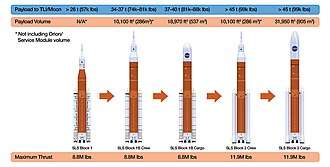
The Space Launch System (SLS) is a US super heavy-lift expendable launch vehicle, which has been under development since its announcement in 2011.
The main launch vehicle planned to be used for the Artemis lunar program, as of May 2020 is the US Space Launch System (SLS). NASA is required to utilize SLS Block 1 by the US Congress to lift a payload of 95 metric tons (209,000 lb) to low Earth orbit (LEO), and will launch Artemis 1, 2, and 3. The later Block 1B is intended to debut the Exploration Upper Stage and launch the notional Artemis 4-7.[52] Block 2 is planned to replace the initial Shuttle-derived boosters with advanced boosters and would have a LEO capability of more than 150 metric tons (330,000 lb), again as required by Congress.[53] Block 2 is intended to enable crewed launches to Mars.[3] The SLS will launch the Orion spacecraft and use the ground operations capabilities and launch facilities at NASA's Kennedy Space Center in Florida. Some variations of the SLS launch manifest has all the blocks being active at the same time rather than one block replacing the last as is common with launchers.
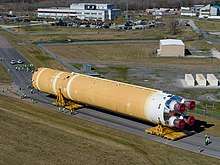
In March 2019, the Trump Administration released its Fiscal Year 2020 Budget Request for NASA. This budget did not initially include any money for the Block 1B and Block 2 variants of SLS but later a request for a budget increase of 1.6 billion dollars towards SLS, Orion, and crewed landers was made. Block 1B is currently intended to debut on Artemis 4 and will be used mainly for co-manifested crew transfers and logistics rather than constructing the Gateway as initially planned. An uncrewed Block was planned to launch the Lunar Surface Asset in 2028, the first lunar outpost of the Artemis program, but now that launch has been moved to a commercial launcher.[54] Block 2 development will most likely start in the late 2020s after NASA is regularly visiting the lunar surface and shifts focus towards Mars.[55]
In October 2019, it was announced NASA had authorized Boeing to purchase materials in bulk for more SLS rockets ahead of the announcement of a new contract. This contract is expected to support up to ten core stages and eight Exploration Upper Stages.[56]
Spacecraft
Orion
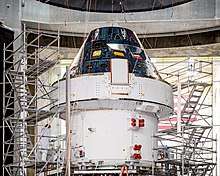
Orion is a class of partially reusable space capsules to be used in NASA's human spaceflight programs. The spacecraft consists of a Crew Module (CM) manufactured by Lockheed Martin and the European Service Module (ESM) manufactured by Airbus Defence and Space. Capable of supporting a crew of six beyond low Earth orbit, Orion can last 21 days undocked and up to six months docked. It is equipped with solar power, an automated docking system, and glass cockpit interfaces modeled after those used in the Boeing 787 Dreamliner. A single AJ10 engine provides the spacecraft's primary propulsion, while eight R-4D-11 engines, and six pods of custom reaction control system engines developed by Airbus, provide the spacecraft's secondary propulsion. Although compatible with other launch vehicles, Orion is primarily designed to launch atop a Space Launch System (SLS) rocket, with a tower launch escape system.
The Orion MPCV was announced by NASA on May 24, 2011.[57] Its design is based on the Crew Exploration Vehicle from the cancelled Constellation program,[58] which had been a 2006 NASA contract award to Lockheed Martin.[59] The command module is being built by Lockheed Martin at the Michoud Assembly Facility,[60] while the Orion service module is being built by Airbus Defence and Space with funding from the European Space Agency.[61][62]
By May 2020, the ESA had signed an agreements with NASA to provide three service modules for Artemis as part of its barter arrangement with NASA to be a member of the Artemis program. The ESMs cost approximately €250 million each to acquire from Airbus, not counting the costs incurred by the ESA directly. The third ESM is slated to fly in 2024.[63]
Lunar Gateway
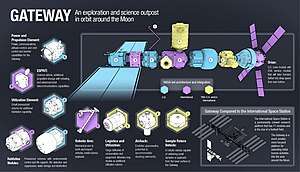
The NASA Lunar Gateway is an in-development mini-space station in lunar orbit intended to serve as a solar-powered communication hub, science laboratory, short-term habitation module, and holding area for rovers and other robots.[64] While the project is led by NASA, the Gateway is meant to be developed, serviced, and utilized in collaboration with commercial and international partners: Canada (CSA), Europe (ESA), and Japan (JAXA).
The Power and Propulsion Element (PPE) started development at the Jet Propulsion Laboratory during the now canceled Asteroid Redirect Mission. The original concept was a robotic, high performance solar electric spacecraft that would retrieve a multi-ton boulder from an asteroid and bring it to lunar orbit for study.[65] When ARM was canceled, the solar electric propulsion was repurposed for the Gateway.[66][67] The PPE will allow access to the entire lunar surface and act as a space tug for visiting craft.[68] It will also serve as the command and communications center of the Gateway.[69][70] The PPE is intended to have a mass of 8-9 tonne and the capability to generate 50 kW[71] of solar electric power for its ion thrusters, which can be supplemented by chemical propulsion.[72] It is planned to launch on a commercial launch vehicle in 2022.[73][74]
The Habitation and Logistics Outpost (HALO),[75][76] also called the Minimal Habitation Module (MHM) and formerly known as the Utilization Module,[77] will be built by Northrop Grumman Innovation Systems (NGIS).[47][78] A commercial launch vehicle would launch the HALO before the end of year 2023. The HALO is based on a Cygnus Cargo resupply module[47] to the outside of which radial docking ports, body mounted radiators (BMRs), batteries and communications antennae will be added. The HALO will be a scaled-down habitation module,[79] yet, it will feature a functional pressurized volume providing sufficient command, control and data handling capabilities, energy storage and power distribution, thermal control, communications and tracking capabilities, two axial and up to two radial docking ports, stowage volume, environmental control and life support systems to augment the Orion spacecraft and support a crew of four for at least 30 days.[78]
According to Doug Loverro, NASA's associate administrator for human exploration and operations, the Gateway construction was removed from the 2024 critical path in order to clear up funding for the HLS. He stated that the PPE could face delays and that moving it back to 2026 would allow for a more refined vehicle. It is also worth noting that the international partners on the Gateway would not have their modules ready until 2026. The only lander capable of operating without the Gateway is Boeing's HLS.[80]
On 30 April 2020, a key to NASA's vision for a "sustainable" crew presence on or near the Moon is the Gateway station. NASA officials originally hoped the Gateway would be in position near the Moon in time for the Artemis 3 mission in 2024, allowing elements of the lunar lander to be assembled, or aggregated, at the Gateway before the arrival of astronauts on an Orion crew capsule. Jim Bridenstine told Spaceflight Now, the Artemis 3 mission will no longer go through the Gateway, but NASA is not backing away from the program.[81]
Moon Cruiser
Designed by Airbus, the Moon Cruiser is a logistics vehicle based off of the ATV and ESM that will be used to support the Gateway. It will be part of ESA's contribution to the Gateway program and As of July 2019 was in the design process. It was planned to be launched on the Ariane 6, the vehicle is being designed to be able to refuel lunar landers and deliver cargo to the Gateway. It is also planned to be used to deliver the European ESPRIT module to the Gateway in 2025. It has also been proposed by Airbus to turn the vehicle into a transfer stage for a lunar lander. Concepts for a lander variant of the vehicle exist but had not received funding by July 2019.[45][82]
Dragon XL
On 27 March 2020, SpaceX revealed the Dragon XL resupply spacecraft designed to carry pressurized and unpressurized cargo, experiments and other supplies to NASA's planned Gateway under a NASA Gateway Logistics Services (GLS) contract. The equipment delivered by Dragon XL missions could include sample collection materials, spacesuits and other items astronauts may need on the Gateway and on the surface of the Moon, according to NASA. It will launch on SpaceX Falcon Heavy rockets from pad 39A at the Kennedy Space Center in Florida. The Dragon XL is planned to stay at the Gateway for six to 12 months at a time when research payloads inside and outside the cargo vessel could be operated remotely, even when crews are not present. Its payload capacity is expected to be more than 5,000 kg (11,000 lb) to lunar orbit. Unlike previous Dragon variants, the spacecraft will not be reusable and instead focuses on transporting cargo. It will act as the United States' logistics vehicle.
Landers
Human Landing System
The Human Landing System (HLS) elements of Artemis are several commercial lunar landing systems that are in early design as of 2020. Each design has dissimilar elements intentionally, to give program design redundancy as NASA plans to contract for the build of two commercial options for the HLS role.
On 16 May 2019, NASA announced 11 contracts worth US$45.5 million in total for studies on transfer vehicles, descent elements, descent element prototypes, refueling element studies and prototypes.[83] One of the requirements is that selected companies will have to contribute at least 20% of the total cost of the project "to reduce costs to taxpayers and encourage early private investments in the lunar economy".[84]
On 30 April 2020, in a teleconference, NASA announced US$967 million in design development funding to three companies (Blue Origin, Dynetics, and SpaceX) to do initial design of HLS landing systems.[85][86][87] At the end of the ten month program, NASA will evaluate which contractors will be offered contracts for initial demonstration missions and select firms for development and maturation of lunar lander systems.[87]
It is not known what time slots each HLS would be contracted for as of May 2020.[87]
| Company | Vehicles | Status |
|---|---|---|
| Aerojet Rocketdyne | One transfer vehicle study | Rejected |
| Blue Origin | Integrated Lander Vehicle (ILV), a three-element lunar lander that is intended to be launched via either New Glenn and ULA Vulcan launch vehicles, and then assembled in lunar orbit. | Selected |
| Boeing | One descent element study, two descent element prototypes, one transfer vehicle study, one transfer vehicle prototype, one refueling element study, and one refueling element prototype | Rejected |
| Dynetics | Dynetics Human Landing System (DHLS), a single structure providing both lunar ascent and descent capabilities, and would launch on the ULA Vulcan launch system. | Selected |
| Lockheed Martin Space Systems | One descent element study, four descent element prototypes, one transfer vehicle study, and one refueling element study | Rejected |
| Masten Space Systems | One descent element prototype | Rejected |
| Maxar (formerly SSL) | One refueling element study and one refueling element prototype | Rejected |
| Northrop Grumman Innovation Systems | One descent element study, four descent element prototypes, one refueling element study, and one refueling element prototype | Rejected |
| OrbitBeyond | Two refueling element prototypes | Rejected |
| Sierra Nevada Corporation | One descent element study, one descent element prototype, one transfer vehicle study, one transfer vehicle prototype, and one refueling element study | Rejected |
| SpaceX | Starship HLS, a fully integrated lander that would use a Lunar design variation of the upper stage of the SpaceX Starship. It would launch using the Super Heavy booster and then serve as its own second stage to complete the ascent to low-Earth orbit. On orbit, it would be refueled before climbing out to lunar orbit to meet Gateway and Orion crew capsule. | Selected |
Integrated Lander Vehicle
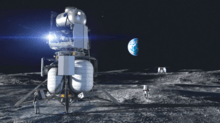
The Integrated Lander Vehicle (ILV) or National Human Landing System (NHLS) is a lunar lander currently development by the "national team" which is led by Blue Origin. It also includes Lockheed Martin, Northrop Grumman, and Draper Laboratory as major partners, as of 2020. The main selling point of the lander is all the components have been in development in one form or another for some time. The transfer stage is based off of the Cygnus spacecraft, the Blue Moon will be used as the descent stage, and the ascent stage will be based on the Orion spacecraft. It will be launched in three parts on both the New Glenn and Vulcan rockets but could be launched on a single SLS Block 1B. The vehicle passes all of NASA's requirements but faces risk with its power and propulsion systems which pose a significant risk to the developmental timeline according to NASA.[88][89]
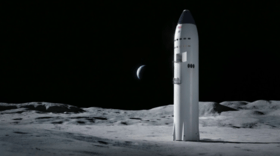
Starship HLS
Starship Human Landing System (Starship HLS) is a lunar landing variant of the SpaceX Starship— planned to be a fully reusable super heavy-lift launch vehicle that has been under development by SpaceX as a self-funded private spaceflight project since 2012— that SpaceX proposed as a non-reusable variant for the human lunar lander component for Artemis. The variant seems to be a standalone dedicated lunar-specific landing system rather than an all-encompassing transport vehicle. This is evident by its lack of heat shielding and fins used to return to Earth. The vehicle appears to have side mounted Super Draco-like engines towards the nose of the vehicle for final descent due to the very high thrust of its main Raptor engines. The nose is now also covered with solar panels. It has a much larger cargo bay and smaller crew area due to lunar missions being much shorter than the general LEO and Mars voyages the base version was designed for. For Artemis, the Starship HLS would launch on its own Super Heavy booster, then be refueled in orbit, and finally sent to lunar orbit. There, an Orion spacecraft would transfer the crew to the vehicle where they would descend and ascend from the surface. The major advantage of Starship is its ability to carry large amounts of cargo as well as its large interior space allowing it to perform long-duration surface missions. SpaceX also has a CLPS contract to deliver payload to the lunar surface with Starship and a contract to deliver supplies to the Lunar Gateway with Dragon XL. NASA has stated that the biggest risk for this proposal would be the complicated reaction control system as well as main propulsion structure.[41][89]
Dynetics HLS
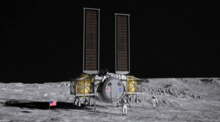
The Dynetics Human Landing System (DHLS) is under development by Dynetics and Sierra Nevada Corporation as well as a multitude of subcontractors. Its design is very similar to early SEI lunar lander proposals (1989–1993) with a low crew cabin and large solar panels, as of 2020. It is the smallest of the three proposals. It consists of a single main structure and would rely on drop tanks to power a majority of the descent. The same main spacecraft structure would then ascend back into orbit and rendezvous with Orion or the Lunar Gateway. The vehicle could also be used to easily deliver large payloads to the lunar surface and could be modified to act as a lunar base module. It will launch on a ULA Vulcan rocket but can also fly on an SLS Block 1B rocket. The biggest issue identified according to NASA is its advanced experimental thrust structure and that it could pose threat to the development time.[90]
Unselected Boeing HLS
The Boeing Human Landing System proposal was submitted to NASA in early November 2019. The lander consists of a descent and ascent stage with the descent stage being able to deorbit the lander which eliminates the need for a third transfer stage. The lander is designed to be launched on an SLS Block 1B rather than assembled in multiple launches. The lander was further planned to not require the Gateway and could dock with Orion directly in order to allow for a simpler mission profile. Boeing had partnered with Intuitive Machines to provide engines,[91] and also planned to reuse key technologies from their CST-100 Starliner.[92] An alternative plan for launching the lander was also detailed: In the event the SLS Block 1B was not ready by 2024, the descent stage could launch on an SLS Block 1 while the ascent stage would be launched by a commercial launcher and assembled in lunar orbit.[93] The Boeing proposal was not selected for design funding by NASA in the April 2020 design funding announcements.[41]
Advanced Exploration Lander
The Advanced Exploration Lander is a three-stage lander concept used as a design reference for commercial proposals. As proposed, after departure from the Gateway, a transfer module would take the crew to a low lunar orbit and then separate, after which the descent module would handle the rest of the journey to the lunar surface. A crew of up to four could spend up to two weeks on the surface before reboarding the ascent module, which would take them back to the Gateway. Each module would have a mass of approximately 12 to 15 metric tons and would be delivered separately by commercial launchers and integrated at the Gateway. The astronauts would board the lander at the Gateway's near-rectilinear halo orbit that goes between about 1,000 and 70,000 kilometers (620 and 43,500 mi) above the Moon, with the circular low orbit about 100 kilometers (62 mi) high. Both the ascent and transfer modules could be designed to be reused, with the descent module left on the lunar surface.
HERACLES
HERACLES (Human-Enhanced Robotic Architecture and Capability for Lunar Exploration and Science) is a planned ESA-JAXA-CSA space cargo transport system that will feature a robotic lunar lander called European Large Logistic Lander (EL3),[94] which can be configured for different operations such as up to 1.5 tons of payload,[95] sample-returns, or prospecting resources found on the Moon.[96] ESA approved the project in November 2019.[95][97][98] Its first mission is envisioned for launch in 2027.[94]
The EL3 lander will be launched directly to the Moon and will have a landing mass of approximately 1,800 kg (4,000 lb).[99] It will be capable of transporting a Canadian robotic rover to explore, prospect potential resources, and load samples up to 15 kg (33 lb) on the ascent module.[100] The rover would then traverse several kilometers across the Schrödinger basin on the far side of the Moon to explore and collect more samples to load on the next EL3 lander.[101][99] The ascent module would return each time to the Lunar Gateway, where it would be captured by the Canadian robotic arm and samples transferred to an Orion spacecraft for transport to Earth with returning astronauts.[102][103]
Astronauts
On 10 January 2020, NASA's 22nd astronaut group, nicknamed the "Turtles", graduated and were assigned to the Artemis program. The group includes two Canadian Space Agency (CSA) astronauts. The group earned their nickname from the prior astronaut group, "The 8-Balls," as is a tradition dating back to "The Mercury Seven" in 1962 which subsequently provided the "Next Nine" with their nickname. They were given this name, for the most part, because of Hurricane Harvey. Some of the astronauts will fly on the Artemis missions to the Moon and may be part of the first crew to fly to Mars.[104]
- Kayla Barron (born 1987): Lt., U.S. Navy
- Zena Cardman (born 1987): Biologist
- Raja Chari (born 1977): Col., U.S. Air Force
- Matthew Dominick (born 1981): Lt. Cmdr., U.S. Navy
- Bob Hines (born 1975): NASA research pilot
- Warren Hoburg (born 1985): assistant professor of Aeronautics and Astronautics, MIT
- Jonny Kim (born 1984): Lt., U.S. Navy physician, former U.S. Navy SEAL
- Robb Kulin (born 1983): Launch Chief Engineer, SpaceX – Resigned in August 2018 before completing his training.[105]
- Jasmin Moghbeli (born 1983): Maj., U.S. Marine Corps
- Loral O'Hara (born 1983): research engineer, Woods Hole Oceanographic Institution
- Francisco Rubio (born 1975): Maj., U.S. Army
- Jessica Watkins (born 1988): Geologist, postdoctoral fellow, California Institute of Technology
- Joshua Kutryk (born 1982): LCol, Royal Canadian Air Force, test pilot, fighter pilot, engineer[106]
- Jenni Sidey (born 1988): Mechanical engineer, combustion scientist, and lecturer[107]
Planned surface operations
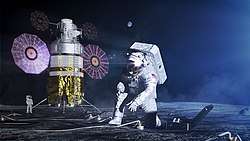
As of February 2020, a lunar stay during a Phase 1 Artemis mission will be about 7 days and will have 5 EVAs. A notional concept of operations (i.e. a hypothetical but possible plan) would include the following: On Day 1 of the stay, astronauts touchdown on the Moon but do not conduct an EVA. Instead, they prepare for the EVA scheduled for the next day in what is referred to as "The Road to EVA". On Day 2, the astronauts open the hatch on the Human Landing System and embark on EVA 1 which will be 6 hours long. It will include collecting a contingency sample, conducting public affairs activities, deploying the experiment package, and acquiring samples. The astronauts will stay close to the landing site on this first EVA. EVA 2 begins on day 3. The astronauts characterize and collect samples from permanently shadowed regions. Unlike the previous EVA, the astronauts will go further from the landing site (up to 2 km) and up and down slopes of 20°. Day 4 will not include an EVA but Day 5 will. EVA 3 may include activities such as collecting samples from an ejecta blanket. Day 6 will have the two astronauts deploy a geotechnical instrument alongside an environmental monitoring station for in-situ resource utilization (ISRU). Day 7 will have the final and shortest EVA. This EVA will only last 1 hour rather than the others' 6 hours in duration from egress to ingress. This EVA mostly comprises preparations for the lunar liftoff, including jettisoning hardware. Once the final EVA is concluded, the astronauts will return into the Human Landing System and the vehicle will launch from the surface and join up with Orion/Gateway.[108]
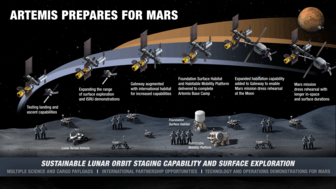
Artemis Base Camp
Artemis Base Camp is the prospective lunar base that would be established at the end of the 2020s. It would consist of three main modules: the Foundational Surface Habitat, the Habitable Mobility Platform, and the Lunar Terrain Vehicle. It would support missions of up to two months and be used to study technologies to use on Mars. It would fall under the guidelines of the Outer Space Treaty.[109]
Foundational Surface Habitat
Little is known about the surface outpost with most information coming from studies and launch manifests that include its launch. It would be commercially built and possibly commercially launched in 2028 along with the Mobile Habitat.[110] The first habitat is referred to as the Artemis Foundation Habitat formerly the Artemis Surface Asset. Current launch manifests show that landing it on the surface would be similar to the HLS. The pressurized habitat would be sent to the Gateway where it would then be attached to a descent stage separately launched from a commercial launcher, it would utilize the same transfer stage used for the HLS. Other designs from 2019 see it being launched from an SLS Block 1B as a single unit and landing directly on the surface. It would then be hooked up to a surface power system launched by a CLPS mission and tested by the Artemis 6 crew. The location of the base would be in the south pole region and most likely be a site visited by prior crewed and robotic missions.[109][5]
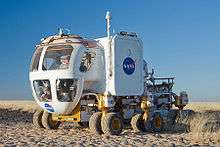
Habitable Mobility Platform
The Habitable Mobility Platform would be a large pressurized rover used to transport crews across large distances. NASA has developed multiple pressurized rovers including the Space Exploration Vehicle built for the Constellation program which was fabricated and tested. In the 2020 flight manifest it was referred to as the Mobile Habitat suggesting it could fill a similar role to the ILREC Lunar Bus. It would be ready for the crew to use on the surface but could also be autonomously controlled from the Gateway or other locations. Japan is currently evaluating a large pressurized lunar rover that would be launched in 2029 to the lunar surface and would be part of their contribution to Artemis surface operations.[109][111][112]
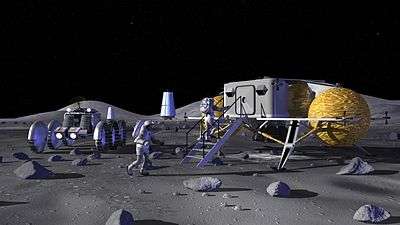
Lunar Terrain Vehicle
As announced in November 2019, NASA will be releasing a request for information for unpressurized lunar rovers. The LTV would be propositioned by a CLPS vehicle before the Artemis 3 mission. It would be used to transport crews around the exploration site. It would serve a similar function as the Apollo Lunar Rover.[109]
VIPER
The VIPER (Volatiles Investigating Polar Exploration Rover) is a lunar rover by NASA planned to be delivered to the surface of the Moon as early as December 2022. The rover will be tasked with prospecting for lunar resources in permanently shadowed areas in the lunar south pole region, especially by mapping the distribution and concentration of water ice. The mission builds on a previous NASA rover concept called Resource Prospector, which was cancelled in 2018.[113]

The VIPER rover is part of the Lunar Discovery and Exploration Program managed by the Science Mission Directorate at NASA Headquarters, and it is meant to support the crewed Artemis program.[114] NASA's Ames Research Center is managing the rover project. The hardware for the rover is being designed by the Johnson Space Center, while the instruments are provided by Ames, Kennedy, and Honeybee Robotics.[114] The project manager is Daniel Andrews, and the project scientist is Anthony Colaprete, who is implementing the technology developed for the now cancelled Resource Prospector rover. The estimated cost of the mission is US$250 million.
The VIPER rover will operate at a south pole region yet to be determined. VIPER is planned to rove several kilometers, collecting data on different kinds of soil environments affected by light and temperature —those in complete darkness, occasional light, and in constant sunlight. Once it enters a permanently shadowed location, it will operate on battery power alone and will not be able to recharge them until it drives to a sunlit area. Its total operation time will be approximately 100 Earth days.
Both the launcher and the lander to be used will be competitively provided through the Commercial Lunar Payload Services (CLPS) contractors. NASA is aiming at landing the rover as early as December 2022.[115]
Space suits

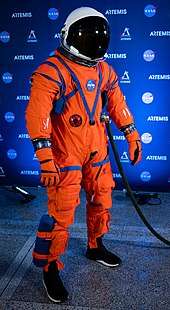
The Artemis program will make use of two space suits: the Exploration Extravehicular Mobility Unit (xEMU),[116] and the Orion Crew Survival System (OCSS).[117]
The xEMU is for use on the lunar surface, with an endurance of up to eight hours. The suit has movable joints and a bearing to allow for movement of the waist. Audio microphones and speakers are located inside the helmet, instead of using the traditional "Snoopy cap". The astronaut enters the suit from between the backpack and the rest of the suit; zippers, which were an issue with the Apollo suits, were excluded.
The OCSS is to be worn inside the Orion spacecraft during launch and re-entry, in case of a depressurization emergency.[117] The outer layer of the suit is orange to allow for visibility in the ocean if astronauts need to exit the spacecraft without any assistance from recovery personnel. The suit includes enhanced shoulder joints for a better range of reach, and greater fire resistance.
Artemis flights
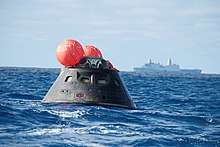
Orion testing
Three tests of the Orion spacecraft have been conducted prior to the launch of Artemis 1. Pad Abort-1, the second and final mission in the preceding Constellation program,[118][119] was a successful test of Orion's launch escape system using a boilerplate capsule on 6 May 2010.[118][120] The second test of Orion was Exploration Flight Test-1 on 5 December 2014.[121][122] A stripped down version of the Orion spacecraft was launched atop a Delta IV Heavy rocket, and its reaction control system was tested in two orbits around Earth, reaching an apogee of 5,800 kilometers (3,600 mi) before making a high-energy reentry at 32,000 kilometers per hour (20,000 mph).[123][124] The third and final test of Orion prior to Artemis 1 was Ascent Abort-2 on 2 July 2019, which tested an updated launch abort system at maximum aerodynamic load,[119][125][126] using a 10,000-kilogram (22,000 lb) Orion test article and a custom launch vehicle built by Orbital Sciences.[126][127]
| Mission | Patch | Launch | Crew | Launch vehicle[lower-alpha 1] | Outcome | Duration |
|---|---|---|---|---|---|---|
| Pad Abort-1 |
|
N/A | Orion Launch Abort System (LAS) | Success | 95 seconds | |
| Exploration Flight Test 1 |
|
N/A |
|
Success | 4 hours 24 minutes | |
| Ascent Abort-2 |
|
N/A | Orion Abort Test Booster | Success | 3 minutes 13 seconds |
Planned missions
As of 2019, all crewed Artemis missions will be launched on the Space Launch System from Kennedy Space Center Launch Complex 39B. Current plans call for some supporting hardware to be launched on other vehicles and from other launch pads.
| Mission | Patch | Launch date | Crew | Launch vehicle | Duration |
|---|---|---|---|---|---|
| Artemis 1 | 2021[129] | N/A | SLS Block 1 Crew | ~25d | |
| Artemis 2 | 2023[130] | TBA | SLS Block 1 Crew | ~10d | |
| Artemis 3 | 2024 | TBA | SLS Block 1 Crew | ~30d |
Proposed missions
A proposal curated by William H. Gerstenmaier before his 10 July 2019 reassignment[131] suggests four launches of the SLS Block 1B launch vehicle with crewed Orion spacecraft and logistical modules to the Gateway between 2024 and 2028.[132][133] The crewed Artemis 4 through 7 would launch yearly between 2025 and 2028,[54] testing in situ resource utilization and nuclear power on the lunar surface with a partially reusable lander. Artemis 7 would deliver in 2028 a crew of four astronauts to a surface lunar outpost known as the Foundation Habitat along with the Mobile Habitat.[54] The Foundation Habitat would be launched back to back with the Mobile Habitat by an undetermined launcher[54] and would be used for extended crewed lunar surface missions.[54][134][135] Prior to each crewed Artemis mission, various payloads to the Lunar Gateway, such as refueling depots and expendable elements of the lunar lander, would be deployed by commercial launch vehicles.[133][135] This would leave three SLS launches for use on interplanetary missions such as the Europa Clipper and Europa Lander or launching the crewed Deep Space Transport for a Mars orbital mission in the 2030s.[136][54][110]
| Mission | Launch date | Crew | Launch vehicle | Duration |
|---|---|---|---|---|
| Artemis 4 | 2025 | TBA | SLS Block 1B Crew | ~30d |
| Artemis 5 | 2026 | TBA | SLS Block 1B Crew | ~30d |
| Artemis 6 | 2027 | TBA | SLS Block 1B Crew | ~30d |
| Artemis 7 | 2028 | TBA | SLS Block 1B Crew | ~30d |
| Artemis 8 | 2029 | TBA | SLS Block 1B Crew | ~60d |
| Artemis 9 | 2030 | TBA | SLS Block 1B Crew | ~60d |
Support missions
Artemis support missions are robotic missions flown through both the CLPS program and Gateway program.[137]
| Year | Mission objective | Mission name | Launch vehicle |
|---|---|---|---|
| 2021 | NRHO Pathfinder mission CAPSTONE | CAPSTONE[138] | Electron |
| Q4 2021 | First launch of the Peregrine 1 lunar lander by Astrobotic[139] | Peregrine 1 | Vulcan[140] |
| Q4 2021 | First launch of the Nova-C lunar lander by Intuitive Machines[44] | Artemis support mission | Falcon 9 |
| 2022 | Tools for mapping the lunar surface temperature, radiation, and hydrogen delivered by Masten | XL-1[141] | Commercial launch vehicle |
| 2022 | PRIME ISRU tech demonstration, lunar ice to H2O | PRIME-1[142] | Commercial launch vehicle |
| Dec 2022[143] | Launch of the Power and Propulsion Element (PPE)[144] | Artemis support mission | Falcon Heavy[143] |
| 2023 [145][146] | Delivery of the Habitation and Logistics Outpost (HALO) to the Gateway | Artemis support mission | Commercial launch vehicle[145] |
| 2023 | Fuel Cells Demo 1 delivered to surface via CLPS lander[110] | Artemis support mission | Commercial launch vehicle |
| Late 2023 [147] | Delivery of NASA's VIPER rover on the Griffin lunar lander to the lunar surface by Astrobotic[147][148] | VIPER | Commercial launch vehicle |
| 2024 | Delivery of expendable ascent element for Artemis 3 | Artemis support mission | Commercial launch vehicle |
| 2024 | Delivery of expendable transfer element for Artemis 3 | Artemis support mission | Commercial launch vehicle |
| 2024 | Delivery of expendable descent element for Artemis 3 | Artemis support mission | Commercial launch vehicle |
| 2024 | Delivery of the Lunar Terrain Vehicle ahead of Artemis 3[149] | Artemis Support Mission | Commercial launch vehicle |
| 2024 | ISRU Subsystems, lunar regolith to O2, performed by crew on surface | Artemis support mission | Commercial launch vehicle |
| 2025 | Delivery of ESPRIT module to the Gateway | Artemis support mission | Commercial launch vehicle |
| 2025 | (Proposed) delivery of expendable ascent element for Artemis 4 | Artemis support mission | Commercial launch vehicle |
| 2025 | (Proposed) delivery of expendable descent element for Artemis 4 | Artemis support mission | Commercial launch vehicle |
| 2025 | (Proposed) delivery of expendable transfer element for Artemis 4 | Artemis support mission | Commercial launch vehicle |
| 2025 | Fuel Cells Demo 2 | Artemis support mission | Commercial launch vehicle |
| 2026 | Delivery of iHAB to the Gateway | Artemis support mission | Commercial launch vehicle |
| 2026 | (Proposed) delivery of reusable ascent element for Artemis 5 | Artemis support mission | Commercial launch vehicle |
| 2026 | (Proposed) delivery of reusable transfer element for Artemis 5 | Artemis support mission | Commercial launch vehicle |
| 2026 | (Proposed) delivery of descent element for Artemis 5 | Artemis support mission | Commercial launch vehicle |
| 2027 | (Proposed) delivery of a Gateway station module | Artemis support mission | Commercial launch vehicle |
| 2027 | (Proposed) refueling of ascent element for Artemis 6 | Artemis support mission | Commercial launch vehicle |
| 2027 | (Proposed) refueling of transfer element for Artemis 6 | Artemis support mission | Commercial launch vehicle |
| 2027 | (Proposed) delivery of descent module for Artemis 6 | Artemis support mission | Commercial launch vehicle |
| 2027 | Cryo Fluid Management Systems | Artemis support mission | Commercial launch vehicle |
| 2027 | Surface power crew demonstration mission | Artemis support mission | Commercial launch vehicle |
| 2028 | (Proposed) delivery of a Gateway station module | Artemis support mission | Commercial launch vehicle |
| 2028 | (Proposed) refueling of ascent element for Artemis 7 | Artemis support mission | Commercial launch vehicle |
| 2028 | (Proposed) refueling of transfer element for Artemis 7 | Artemis support mission | Commercial launch vehicle |
| 2028 | (Proposed) delivery of descent module for Artemis 7 | Artemis support mission | Commercial launch vehicle |
| 2028 | (Proposed) delivery of the Foundation Hab to the lunar south pole[110] | Artemis support mission | Space Launch System Block 1B / 2 |
| 2028 | (Proposed) delivery of the Mobile Hab to the lunar south pole | Artemis support mission | Space Launch System Block 1B / 2 |
| 2029 | (Proposed) refueling of ascent element for Artemis 8 | Artemis support mission | Commercial launch vehicle |
| 2029 | (Proposed) refueling of transfer element for Artemis 8 | Artemis support mission | Commercial launch vehicle |
| 2029 | (Proposed) delivery of descent module for Artemis 8 | Artemis support mission | Commercial launch vehicle |
| 2030 | (Proposed) refueling of ascent element for Artemis 9 | Artemis support mission | Commercial launch vehicle |
| 2030 | (Proposed) refueling of transfer element for Artemis 9 | Artemis support mission | Commercial launch vehicle |
| 2030 | (Proposed) refueling of ascent element for Artemis 9 | Artemis support mission | Commercial launch vehicle |
Criticism
The Artemis program has received criticisms from several space professionals:
Mark Whittington, who is a contributor to The Hill and an author of several space exploration studies, stated in an article that the "lunar orbit project doesn't help us get back to the Moon".[150]
Aerospace engineer, author, and Mars Society founder Robert Zubrin has voiced his distaste for the Lunar Gateway which is part of the Artemis program as of 2019. He presented an alternative approach to a 2024 crewed lunar landing called Moon Direct, a successor to his proposed Mars Direct. His vision phases out the SLS and Orion, replacing them with the SpaceX launch vehicles and Dragon 2. It also proposes using a heavy ferry/lander that would be refueled on the lunar surface via In situ resource utilization and transfer the crew from LEO to the lunar surface. The concept bears a heavy resemblance to NASA's own Space Transportation System proposal from the 1970s.
Former Apollo 11 astronaut Buzz Aldrin disagrees with NASA's current goals and priorities, including their plans for a lunar outpost. He also questioned the benefit of the idea to "send a crew to an intermediate point in space, pick up a lander there and go down". However, Aldrin expressed support for Robert Zubrin's Moon Direct concept which involves lunar landers traveling from Earth orbit to the lunar surface and back.[151]
House Authorization Bill of 2020
The leadership of the House Science Committee introduced a bipartisan NASA authorization bill on 24 January 2020 that would significantly alter NASA's current plans to return humans to the Moon and rather would focus on a Mars orbital mission in 2033. Bill H.R. 5666 would change the lunar landing date from 2024 to 2028 and put the program as a whole underneath a larger space exploration plan. The bill is currently stuck in the House Committee on Science, Space, and Technology and there have been no committee votes or further action as of May 2020. Major proposed changes include:[152][153]
- Creation of a new Moon to Mars program office with a goal of landing humans on Mars "in a sustainable manner as soon as practicable"
- A 2028 target date for a lunar landing to allow the technology to mature
- A NASA developed expendable Human Landing System (HLS), something along the line of the Advanced Exploration Lander or the expendable Altair design
- An integrated Orion / HLS system launching on a single Space Launch System Block 1B, similar to the Saturn / Apollo combination possibly using the Boeing HLS design
- The requirement one uncrewed and one crewed test flight of the HLS before a lunar landing is attempted, something not currently required
- Once operational, the system would perform two lunar landings a year rather than one
- No base would be set up on the lunar surface rather, the missions would follow the "flag and footsteps" approach of Apollo
- Development of the Lunar Gateway as a separate program to test Mars transportation technologies and not be required for lunar operations
- ISRU technologies would be managed under a program separate from the Moon to Mars campaign and not be required for either mission
- International Space Station funding would be extended to 2030
Gallery
 Planned missions of Artemis program
Planned missions of Artemis program Phase 1 Gateway with an Orion and HLS docked on Artemis 3
Phase 1 Gateway with an Orion and HLS docked on Artemis 3 Concept of surface operations
Concept of surface operations
See also
- Apollo program – 1961–1972 program which landed the first men on the Moon
- Colonization of the Moon – Proposed establishment of a permanent human community or robotic industries on the Moon
- Commercial Crew Development
- Deep Space Transport – A crewed interplanetary spacecraft concept
- First Lunar Outpost - A crewed lunar program proposal from the SEI
- List of crewed spacecraft
- Space policy of the United States
- International Lunar Resources Exploration Concept – Lunar exploration concept
- NASA Astronaut Group 23
- Boeing Lunar Lander
References
Notes
- Serial number displayed in parentheses.
Sources
- Bridenstine, Jim; Grush, Loren. "NASA administrator on new Moon plan: 'We're doing this in a way that's never been done before'". The Verge. Archived from the original on 25 May 2019. Retrieved 25 May 2019.CS1 maint: ref=harv (link)
- Berger, Eric (20 May 2019). "NASA's full Artemis plan revealed: 37 launches and a lunar outpost". Ars Technica. Archived from the original on 23 May 2019. Retrieved 23 May 2019.CS1 maint: ref=harv (link)
- Foust, Jeff (24 May 2019). "NASA Has a Full Plate of Lunar Missions Before Astronauts Can Return to Moon". Space.com. Archived from the original on 25 May 2019. Retrieved 25 May 2019.CS1 maint: ref=harv (link)
- Grush, Loren (3 October 2018). "This is Lockheed Martin's idea for a reusable lander that carries people and cargo to the Moon". The Verge. Archived from the original on 3 October 2018. Retrieved 18 October 2018.CS1 maint: ref=harv (link)
- Hill, Bill (27 August 2018). "Exploration Systems Development Update" (PDF). National Aeronautics and Space Administration (NASA). Retrieved 17 October 2018.CS1 maint: ref=harv (link)
- Sloss, Philip (11 September 2018). "NASA updates Lunar Gateway plans". NASASpaceFlight.com. Archived from the original on 17 October 2018. Retrieved 17 October 2018.CS1 maint: ref=harv (link)
- "S.3729 - National Aeronautics and Space Administration Authorization Act of 2010". United States Congress. 11 October 2010.
Citations
- Berger, Eric (11 February 2020). "NASA puts a price on a 2024 Moon landing—$35 billion". Ars Technica. Retrieved 11 February 2020.
- "NASA: Moon to Mars". NASA. Retrieved 19 May 2019.
- Gebhardt, Chris (6 April 2017). "NASA finally sets goals, missions for SLS—eyes multi-step plan to Mars". NASASpaceFlight.com. Retrieved 21 August 2017.
- Grush, Loren (18 July 2019). "NASA's daunting to-do list for sending people back to the Moon". The Verge. Retrieved 28 August 2019.
- Berger, Eric (20 May 2020). "NASA's full Artemis plan revealed: 37 launches and a lunar outpost". Ars Technica. Retrieved 24 May 2020.
- "NASA Gains Broad International Support for Artemis Program at IAC". NASA. 8 November 2019. Retrieved 24 May 2020.
- "NASA: Artemis Accords". NASA.gov. Retrieved 16 May 2020.
- NASA administrator on new Moon plan: 'We're doing this in a way that's never been done before'. Loren Grush, The Verge. 17 May 2019.
- Harwood, William (17 July 2019). "NASA boss pleads for steady moon mission funding". CBS News. Retrieved 28 August 2019.
- Senate appropriators advance bill funding NASA despite uncertainties about Artemis costs. Jeff Foust, Space News. 27 September 2019.
- Fernholz, Tim; Fernholz, Tim. "Trump wants $1.6 billion for a moon mission and proposes to get it from college aid". Quartz. Retrieved 14 May 2019.
- Berger, Eric (14 May 2019). "NASA reveals funding needed for Moon program, says it will be named Artemis". Ars Technica. Retrieved 22 May 2019.
- Bonilla, Dennis (8 September 2009). "Charter of the Review of U.S. Human Space Flight Plans Committee". NASA. Retrieved 9 September 2009.
- Review of U.S. Human Space Flight Plans Committee; Augustine; Austin; Chyba; et al. "Seeking A Human Spaceflight Program Worthy of A Great Nation" (PDF). Final Report. NASA. Retrieved 15 April 2010.
- "President Barack Obama on Space Exploration in the 21st Century". Nasa.gov.
- "S.3729 - National Aeronautics and Space Administration Authorization Act of 2010". United States Congress. 11 October 2010.
- Clark, Stephen. "Trump signs order reviving long-dormant National Space Council – Spaceflight Now".
- Pearlman, Robert (14 May 2019). "NASA Names New Moon Landing Program Artemis After Apollo's Sister". Space.com. Retrieved 14 May 2019.
- Chang, Kenneth (13 May 2019). "For Artemis Mission to Moon, NASA Seeks to Add Billions to Budget". The New York Times. ISSN 0362-4331. Retrieved 21 July 2019.
- Clark, Stephen. "Boeing proposes SLS-launched lunar lander – Spaceflight Now". Retrieved 3 March 2020.
- Berger, Eric (27 February 2020). "NASA planning document may offer clues to changes in Artemis program". Ars Technica. Retrieved 28 February 2020.
- Burghardt, Thomas (14 May 2019). "NASA aims for quick start to 2024 Moon landing via newly named Artemis Program". NASASpaceFlight. Retrieved 28 August 2019.
- Harwood, William (31 May 2019). "NASA taps three companies for commercial moon missions". CBS News. Retrieved 28 August 2019.
- Foust, Jeff (31 May 2019). "NASA awards contracts to three companies to land payloads on the moon". SpaceNews. Retrieved 28 August 2019.
- Bergin, Chris (19 March 2018). "NASA courts commercial options for Lunar Landers". NASASpaceFlight. Archived from the original on 8 May 2018. Retrieved 18 October 2018.
NASA's new Commercial Lunar Payload Services (CLPS) effort to award contracts to provide capabilities as soon as 2019.
- "NASA Expands Plans for Moon Exploration: More Missions, More Science". NASA. Retrieved 4 June 2018.
- Foust, Jeff (28 April 2018). "NASA emphasizes commercial lunar lander plans with Resource Prospector cancellation". SpaceNews. Archived from the original on 18 October 2018. Retrieved 18 October 2018.
... selected but unspecified instruments from RP will instead be flown on future commercial lunar lander missions under a new Commercial Lunar Payload Services (CLPS) program. NASA released a draft request for proposals for that program April 27. [...] Under CLPS, NASA plans to issue multiple indefinite-delivery indefinite-quantity (IDIQ) contracts to companies capable of delivering payloads to the lunar surface. Companies would have to demonstrate their ability to land at least 10 kilograms of payload on the lunar surface by the end of 2021.
- Werner, Debra (24 May 2018). "NASA to begin buying rides on commercial lunar landers by year's end". SpaceNews. Archived from the original on 18 October 2018. Retrieved 18 October 2018.
NASA also will look for payloads for the miniature landers in addition to landers capable of delivering 500 to 1,000 kilograms to the surface of the Moon.
- "NASA Announces New Partnerships for Commercial Lunar Payload Delivery Services" (Press release). NASA. 29 November 2018. Retrieved 29 November 2018.
- "NASA chooses three companies to send landers to the moon". UPI. Retrieved 1 June 2019.
- "Commercial lunar lander company terminates NASA contract". SpaceNews.com. 30 July 2019. Retrieved 30 July 2019.
- Richardson, Derek (26 February 2019). "NASA selects experiments to fly aboard commercial lunar landers". Spaceflight Insider. Retrieved 28 August 2019.
- Hautaluoma, Grey (1 July 2019). "NASA Selects 12 New Lunar Science, Technology Investigations" (Press release). NASA. Retrieved 28 August 2019.
- "DRAFT Lunar Surface Instrument and Technology Payloads Call for Community Comment". SSERVI. NASA. 14 February 2018. Retrieved 17 August 2019.
- "NASA Selects Experiments for Possible Lunar Flights in 2019" (Press release). NASA. 21 February 2019. Retrieved 28 August 2019.
- Grush, Loren (18 November 2019). "NASA partners with SpaceX, Blue Origin, and more to send large payloads to the Moon". The Verge. Retrieved 11 December 2019.
- "New Companies Join Growing Ranks of NASA Partners for Artemis Program". NASA (Press release). 18 November 2019. Retrieved 11 December 2019.
- "NASA selects Masten Space Systems to deliver cargo to the Moon in 2022".
- "Masten Space Systems Awarded $76M to Help NASA Deliver Lunar Sci-Tech Payloads".
- Jeff Foust (9 July 2019). "Firefly to partner with IAI on lunar lander". Space News. Retrieved 15 September 2019.
- Sheetz, Michael (30 April 2020). "NASA awards contracts to Jeff Bezos and Elon Musk to land astronauts on the moon". CNBC. Retrieved 30 April 2020.
- "Exclusive: Trump administration drafting 'Artemis Accords' pact for moon mining - sources". Reuters. 6 May 2020. Retrieved 15 May 2020.
- Wall, Mike (15 May 2020). "NASA lays out 'Artemis Accords' for responsible moon exploration". workSpace.com. Retrieved 16 May 2020.
- Berger, Eric (31 May 2019). "NASA picks three companies to attempt Moon landings in 2020 and 2021". Ars Technica. Retrieved 17 December 2019.
- Barensky, Stefan (24 July 2019). "Airbus propose un remorqueur translunaire". Aerospatium (in French). Retrieved 10 January 2020.
- "NASA FY 2019 Budget Overview" (PDF). NASA. p. 14.
Supports launch of the Power and Propulsion Element on a commercial launch vehicle as the first component of the LOP - Gateway
- Foust, Jeff (23 July 2019). "NASA to sole source Gateway habitation module to Northrop Grumman". SpaceNews. Retrieved 28 August 2019.
- Sloss, Philip (11 September 2018). "NASA updates Lunar Gateway plans". NASASpaceFlight.com. Archived from the original on 17 October 2018. Retrieved 17 October 2018.CS1 maint: ref=harv (link)
- Gebhardt, Chris (17 June 2019). "NASA determining the best course for commercial Lunar Gateway resupply". NASASpaceFlight. Retrieved 28 August 2019.
- Aguiar, Laura (14 June 2019). "NASA to Partner with American Industry to Supply Artemis Moon Missions" (Press release). NASA. Retrieved 28 August 2019.
- Weitering, Hanneke (23 May 2019). "NASA Has a Full Plate of Lunar Missions Before Astronauts Can Return to Moon". Space.com. Retrieved 28 August 2019.
And before NASA sends astronauts to the moon in 2024, the agency will first have to launch five aspects of the lunar Gateway, all of which will be commercial vehicles that launch separately and join each other in lunar orbit. First, a power and propulsion element will launch in 2022. Then, the crew module will launch (without a crew) in 2023. In 2024, during the months leading up to the crewed landing, NASA will launch the last critical components: a transfer vehicle that will ferry landers from the Gateway to a lower lunar orbit, a descent module that will bring the astronauts to the lunar surface, and an ascent module that will bring them back up to the transfer vehicle, which will then return them to the Gateway.
- "Space Launch System". aerospaceguide.net.
- "The NASA Authorization Act of 2010". Featured Legislation. Washington DC, United States: United States Senate. 15 July 2010. Archived from the original on 10 April 2011. Retrieved 28 August 2019.
- "America to the Moon 2024" (PDF).
- Kyle, Ed (16 May 2019). "NASA's Space Launch System". Space Launch Report. Retrieved 22 May 2019.
- Loff, Sarah (16 October 2019). "NASA Commits to Future Artemis Missions With More SLS Rocket Stages". NASA. Archived from the original on 17 October 2019. Retrieved 18 October 2019.
- Wall, Mike (24 May 2011). "NASA Unveils New Spaceship for Deep Space Exploration". Space.com. Retrieved 24 May 2011.
- Moen, Marina M. "Feasibility of Orion Crew Module Entry on Half of Available Propellant Due to Tank Isolation Fault". American Institute of Aeronautics and Astronautics. NASA Langley Research Center. hdl:2060/20110014641.
- "NASA Selects Lockheed Martin To Be Orion Crew Exploration Vehicle Prime Contractor" (Press release). NASA. 31 August 2006. Retrieved 31 August 2006.
- "Michoud Assembly Facility Lockheed Martin Webpage". NASA. Retrieved 27 November 2018.
- "NASA Signs Agreement for a European-Provided Orion Service Module". nasa.gov. January 16, 2013. Archived from the original on March 28, 2014. Retrieved March 28, 2014.
- "ESA workhorse to power NASA's Orion spacecraft / Research / Human Spaceflight / Our Activities / ESA". Esa.int. 16 January 2013. Retrieved 15 July 2014.
- de Selding, Peter (26 May 2020). "ESA signs ~ EUR 250M ($305M) w/ @AirbusSpace to build 3rd Orion service module as part of existing barter agreement with @NASA. This model will fly in 2024 in NASA Artemis mission sending astronauts to Moon. ESA funds were approved at last November's council of ESA govts". Retrieved 26 May 2020.
- Jackson, Shanessa (11 September 2018). "Competition Seeks University Concepts for Gateway and Deep Space Exploration Capabilities". nasa.gov. NASA. Retrieved 19 September 2018.
- Greicius, Tony (20 September 2016). "JPL Seeks Robotic Spacecraft Development for Asteroid Redirect Mission". NASA. Retrieved 30 May 2019.
- "NASA closing out Asteroid Redirect Mission". SpaceNews.com. 14 June 2017. Retrieved 30 May 2019.
- "Asteroid Redirect Robotic Mission". jpl.nasa.gov. Retrieved 30 May 2019.
- ** (25 May 2019). "NASA awards Artemis contract for lunar gateway power, propulsion". Aerotech News & Review. Retrieved 30 May 2019.CS1 maint: numeric names: authors list (link)
- "Deep Space Gateway and Transport: Concepts for Mars, Moon Exploration Unveiled | Space Exploration | Sci-News.com". Breaking Science News | Sci-News.com. Retrieved 30 May 2019.
- Clark, Stephen (24 May 2019). "NASA chooses Maxar to build keystone module for lunar Gateway station". Spaceflight Now. Retrieved 30 May 2019.
- Foust, Jeff (3 November 2017). "NASA issues study contracts for Deep Space Gateway element". SpaceNews. Retrieved 11 December 2019.
- Gebhardt, Chris (6 April 2017). "NASA finally sets goals, missions for SLS – eyes multi-step plan to Mars". NASASpaceflight. Retrieved 9 April 2017.
- "NASA FY 2019 Budget Overview" (PDF). NASA. 9 February 2018. Retrieved 11 December 2019.
Supports launch of the Power and Propulsion Element on a commercial launch vehicle as the first component of the LOP - Gateway.
- Foust, Jeff (30 March 2018). "NASA considers acquiring more than one gateway propulsion module". SpaceNews. Retrieved 11 December 2019.
- Foust, Jeff (30 August 2019). "ISS partners endorse modified Gateway plans". SpaceNews. Retrieved 11 December 2019.
- NASA Asks American Companies to Deliver Supplies for Artemis Moon Missions. NASA Press Release M019-14. 23 August 2019.
- Planetary Society. "Humans in Deep Space". planetary.org. Retrieved 6 August 2019.
- "Justification for other than full and open competition (JOFOC) for the Minimal Habitation Module (MHM)". Federal Business Opportunities. NASA. Retrieved 23 July 2019.
- Messier, Doug (23 July 2019). "NASA Awards Contract to Northrop Grumman for Lunar Gateway Habitat Module". Parabolic Arc. Retrieved 11 December 2019.
- "NASA takes Gateway off the critical path for 2024 lunar return". SpaceNews.com. 13 March 2020. Retrieved 16 March 2020.
- "Blue Origin wins lion's share of NASA funding for human-rated lunar lander". spaceflightnow.com. SFN. 30 April 2020. Retrieved 30 April 2020.
- "Fly me to the Moon… with Airbus". Airbus. Retrieved 10 January 2020.
- Gina Anderson; Cheryl Warner (16 May 2019). "NASA Taps 11 American Companies to Advance Human Lunar Landers" (Press release). NASA. Retrieved 17 May 2019.
- Raven, Benjamin (22 May 2019). "NASA awards $45.5M to 11 American companies to "advance human lunar landers"". MLive.com. Retrieved 28 August 2019.
- Burghardt, Thomas (1 May 2020). "NASA Selects Blue Origin, Dynetics, and SpaceX Human Landers for Artemis". NASASpaceFlight.com. Retrieved 12 June 2020.
- Berger, Eric (30 April 2020). "NASA awards lunar lander contracts to Blue Origin, Dynetics—and Starship". Ars Technica. Retrieved 12 June 2020.
- Potter, Sean (30 April 2020). "NASA Names Companies to Develop Human Landers for Artemis Missions". NASA. Retrieved 12 June 2020.
- Potter, Sean (30 April 2020). "NASA Names Companies to Develop Human Landers for Artemis Missions". NASA. Retrieved 30 April 2020.
- "NASA Selects Blue Origin, Dynetics, and SpaceX Human Landers for Artemis". NASASpaceFlight.com. 1 May 2020. Retrieved 1 May 2020.
- Mahoney, Erin (30 April 2020). "NASA Selects Blue Origin, Dynetics, SpaceX for Artemis Human Landers". NASA. Retrieved 9 June 2020.
- "Intuitive Machines selected to build engines for Boeing's Human Lander System Technology Development". Intuitive Machines. 24 October 2019. Retrieved 9 November 2019.
- "Boeing Proposes "Fewest Steps to the Moon" for NASA's Human Lander".
- Clark, Stephen. "Boeing proposes SLS-launched lunar lander—Spaceflight Now". Retrieved 11 November 2019.
- Helping Heracles EL3 to Survive the Long, Cold, Dark Lunar Nights. Doug Messier, Parabolic Arc. 8 December 2019.
- Funding Europe's space ambitions. Jeff Foust, The Space Review. December 2019.
- "The Heracles European Large Logistic Lander". ESA. Retrieved 10 December 2019.
- Hera mission is approved as ESA receives biggest ever budget. Kerry Hebden, Room'. 29 November 2019.
- ESA declares success at ministerial meeting. Jeff Foust, Space News. 28 November 2019,
- Landing on the Moon and returning home: Heracles. ESA. Accessed on 10 December 2019.
- HERACLES: An ESA-JAXA-CSA Joint Study on Returning to the Moon. H. Hiesinger, M. Landgraf, W. Carey, Y. Karouji, T. Haltigin, G. Osinski, U. Mall, K. Hashizume, HERACLES Science Working Group, HERACLES International Science Definition Team. 50th Lunar and Planetary Science Conference 2019 (LPI Contrib. No. 2132)
- Landgraf, Markus; Carpenter, James; Sawada, Hirotaka (20–22 October 2015). HERACLES Concept - An International Lunar Exploration Study (PDF). Lunar Exploration Analysis Group (2015). Bibcode:2015LPICo1863.2039L. Retrieved 28 August 2019.
- "Landing on the Moon and returning home: Heracles". ESA. 7 June 2019. Retrieved 28 August 2019.
- Lunar Robotic Mission Heracles Will Scout for Human Landings. Elizabeth Howell, Space. 28 June 2019.
- January 2020, Robert Z. Pearlman 10. "NASA graduates new class of astronauts to join Artemis-era missions". Space.com.
- "NASA astronaut candidate resigns prior to qualifying for spaceflight | collectSPACE". collectSPACE.com.
- https://www.asc-csa.gc.ca/eng/astronauts/canadian/active/bio-joshua-kutryk.asp
- "2017 Astronaut Candidates Available for Interviews Before Training". NASA. 16 August 2017.
- "Exploration EVA System Concept of Operations Summary for Artemis Phase 1 Lunar Surface Mission" (PDF). NASA Technical Report Server. NASA. Retrieved 18 April 2020.
- "NASA's Plan for Sustained Lunar Exploration and Development" (PDF).
- February 2020, Hanneke Weitering 12. "NASA has a plan for yearly Artemis moon flights through 2030. The first one could fly in 2021". Space.com. Retrieved 20 February 2020.
- "NASA to seek ideas for an Artemis lunar rover". SpaceNews.com. 20 November 2019. Retrieved 24 January 2020.
- "NASA - Three Days in the Desert Tests Lunar "RV"". www.nasa.gov. Retrieved 24 January 2020.
- "VIPER (rover)", Wikipedia, 20 December 2019, retrieved 7 January 2020
- Loff, Sarah (23 October 2019). "New VIPER Lunar Rover to Map Water Ice on the Moon". NASA. Retrieved 7 January 2020.
- Bartels 2019-10-25T21:30:31Z, Meghan. "NASA Will Launch a Lunar VIPER to Hunt Moon Water in 2022". Space.com. Retrieved 7 January 2020.
- Mahoney, Erin (4 October 2019). "A Next Generation Spacesuit for the Artemis Generation of Astronauts". NASA. Retrieved 24 October 2019.
- Crane, Aimee (15 October 2019). "Orion Suit Equipped to Expect the Unexpected on Artemis Missions". NASA. Retrieved 24 October 2019.
- Pearlman, Robert (6 May 2010). "NASA tests Pad Abort system, building on 50 years of astronaut escape system tests". collectSPACE. Archived from the original on 25 May 2019. Retrieved 25 May 2019.
The Orion Pad Abort-1 team has successfully tested the first U.S. designed abort system since Apollo," said Doug Cooke, NASA's associate administrator for the exploration systems directorate, at a post-flight briefing [...] The PA1 test was conducted under NASA's Constellation program, which a former NASA administrator described as "Apollo on steroids.
- Sloss, Philip (24 May 2019). "NASA Orion AA-2 vehicle at the launch pad for July test". NASASpaceFlight.com. Archived from the original on 25 May 2019. Retrieved 25 May 2019.
This will be the second and final planned LAS test following the Pad Abort-1 (PA-1) development test conducted in 2010 as a part of the ccanceled [sic] Constellation Program and the abort system design changed from PA-1 to AA-2 both inside and outside [...] in preparation for a scheduled daybreak test on 2 July.
- David, Leonard (25 May 2019). "NASA Test Launches Rocket Escape System for Astronauts". Space.com. Archived from the original on 25 May 2019. Retrieved 25 May 2019.
Called Pad Abort-1, the $220 million Orion escape system test showcased the system that could be used to rescue a crew and its spacecraft in case of emergencies at the launch pad.
- Davis, Jason (5 December 2014). "Orion Returns to Earth after Successful Test Flight". The Planetary Society. Retrieved 25 May 2019.
NASA's Orion spacecraft returned safely to Earth this morning following a picture-perfect test mission. [...] Orion itself was originally part of NASA's now-defunct Constellation program, and is now a key component of the space agency's Mars plans.
- Clark, Stuart; Sample, Ian; Yuhas, Alan (5 December 2014). "Orion spacecraft's flawless test flight puts Mars exploration one step closer". The Guardian. Archived from the original on 25 May 2019. Retrieved 25 May 2019.
The launch at 12.05pm GMT aboard a Delta IV heavy rocket from Cape Canaveral, Florida, was as free of problems as Thursday's aborted attempt was full of them. Immediately, Nasa tweeted "Liftoff! #Orion's flight test launches a critical step on our #JourneytoMars".
- Kramer, Miriam (5 December 2014). "Splashdown! NASA's Orion Spaceship Survives Epic Test Flight as New Era Begins". Space.com. Archived from the original on 17 October 2018. Retrieved 17 October 2018.
Orion's key systems were put to the test during the flight, which launched atop a United Launch Alliance Delta 4 Heavy rocket [...] the craft hit Earth's atmosphere as the capsule was flying through space at about 20,000 mph (32,000 km/h).
- Spaceflight Now staff (4 December 2014). "Orion Exploration Flight Test No. 1 timeline". Spaceflight Now. Archived from the original on 9 December 2014. Retrieved 17 October 2018.
The first orbital test flight of NASA's Orion crew capsule will lift off on top of a United Launch Alliance Delta 4 rocket from Cape Canaveral]s Complex 37B launch pad. The rocket will send the uncrewed crew module 3,600 miles above Earth ...
- Phys.org staff (3 August 2018). "Image: The Orion test crew capsule". Phys.org. Archived from the original on 17 October 2018. Retrieved 17 October 2018.
In the Ascent Abort-2 test, NASA will verify that the Orion spacecraft's launch abort system can steer the capsule and astronauts inside it to safety in the event of an issue with the Space Launch System rocket when the spacecraft is under the highest aerodynamic loads it will experience during ascent ...
- Johnson Space Center (November 2017). "Ascent Abort Flight Test-2" (PDF). National Aeronautics and Space Administration (NASA). Retrieved 17 October 2018.
In April 2019, Orion is scheduled to undergo a full-stress test of the LAS, called Ascent Abort Test 2 (AA-2), where a booster provided by Orbital ATK will launch from Cape Canaveral Air Force Station in Florida, carrying a fully functional LAS and a 22,000-pound Orion test vehicle ...
- Orbital Sciences Corporation (11 April 2007). "Orbital to Provide Abort Test Booster for NASA Testing". Northrop Grumman. Archived from the original on 25 May 2019. Retrieved 25 May 2019.
Orbital Sciences Corporation (NYSE:ORB) today announced that it has been selected [...] to design and build the next-generation NASA Orion Abort Test Booster (ATB).
- Brown, Katherine (2 July 2019). "Successful Orion Test Brings NASA Closer to Moon, Mars Missions". NASA. Retrieved 2 July 2019.
- Grush, Loren (22 January 2020). "NASA administrator on the year ahead: 'A lot of things have to go right'". The Verge. Retrieved 22 January 2020.
- "NASA will likely add a rendezvous test to the first piloted Orion space mission". 18 May 2020.
- Davenport, Christion (10 July 2019). "Shakeup at NASA as space agency scrambles to meet Trump moon mandate". The Washington Post. Retrieved 10 July 2019.
- Berger 2019, "Developed by the agency's senior human spaceflight manager, Bill Gerstenmaier, this plan is everything Pence asked for—an urgent human return, a Moon base, a mix of existing and new contractors."
- Foust 2019, "After Artemis 3, NASA would launch four additional crewed missions to the lunar surface between 2025 and 2028. Meanwhile, the agency would work to expand the Gateway by launching additional components and crew vehicles and laying the foundation for an eventual moon base."
- Berger 2019, "This decade-long plan, which entails 37 launches of private and NASA rockets, as well as a mix of robotic and human landers, culminates with a "Lunar Surface Asset Deployment" in 2028, likely the beginning of a surface outpost for long-duration crew stays."
- Berger 2019, [Illustration] "NASA's "notional" plan for a human return to the Moon by 2024, and an outpost by 2028."
- Independent report concludes 2033 human Mars mission is not feasible. Jeff Foust, Space News. 18 April 2019.
- "America to the Moon 2024 - Optimized" (PDF). nasa.gov.
- February 2020, Mike Wall 18. "Rocket Lab will launch a cubesat to the moon for NASA next year". Space.com. Retrieved 20 February 2020.
- Potter, Sean (31 May 2019). "NASA Selects First Commercial Moon Landing Services for Artemis". NASA. Retrieved 17 December 2019.
- "Astrobotic Selects United Launch Alliance Vulcan Centaur Rocket to Launch its First Mission to the Moon". ulalaunch.com. Retrieved 17 December 2019.
- "NASA selects Masten Space Systems to deliver cargo to the Moon in 2022". TechCrunch. Retrieved 12 April 2020.
- "NASA Lunar ISRU Strategy" (PDF).
- "NASA Assessments of Major Projects April 2020" (PDF). US Government Accountability Office.
- Daines, Gary (1 December 2016). "Crew Will Mark Important Step on Journey to Mars". Nasa.gov. Retrieved 2 January 2018.
- Foust, Jeff (23 July 2019). "NASA to sole source Gateway habitation module to Northrop Grumman". SpaceNews. Retrieved 11 December 2019.
- Messier, Doug (23 July 2019). "NASA Awards Contract to Northrop Grumman for Lunar Gateway Habitat Module". Parabolic Arc. Retrieved 11 December 2019.
- "NASA Selects Astrobotic to Fly Water-Hunting Rover to the Moon". NASA. 11 June 2020. Retrieved 24 June 2020.
- Loff, Sarah (23 October 2019). "New VIPER Lunar Rover to Map Water Ice on the Moon". NASA. Retrieved 17 December 2019.
- November 2019, Elizabeth Howell 22. "NASA Eyes a New Moon Rover for Astronauts and Robot Lunar Explorers". Space.com. Retrieved 5 April 2020.
- Whittington, Mark (16 June 2018). "NASA's unnecessary $504 million lunar orbit project doesn't help us get back to the Moon". The Hill. Retrieved 20 December 2018.
- Foust, Jeff (16 November 2018). "Advisory group skeptical of NASA lunar exploration plans". SpaceNews. Retrieved 20 December 2018.
- "House introduces NASA authorization bill that emphasizes Mars over moon". SpaceNews.com. 25 January 2020. Retrieved 27 January 2020.
- Clark, Stephen. "Bipartisan House bill spurns 2024 moon landing goal, favoring focus on Mars – Spaceflight Now". Retrieved 27 January 2020.
External links
![]()
- Moon to Mars portal at NASA
- Artemis program at NASA
- Monthly report by the Exploration Systems Development (ESD)


